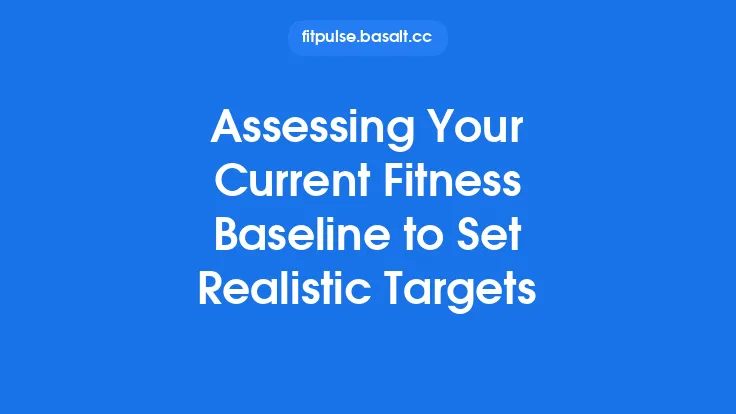Cardiorespiratory fitness (CRF) is a cornerstone of overall health, influencing everything from disease risk to functional independence. While direct measurement of maximal oxygen uptake (VO₂max) remains the gold‑standard, it requires maximal effort, specialized equipment, and often a clinical setting—factors that limit its routine use in many fitness and health‑promotion contexts. Submaximal exercise tests bridge this gap by providing reliable estimates of CRF from effort levels that are well below an individual’s true maximal capacity. Because they are safer, quicker, and more accessible, submaximal protocols have become essential tools for clinicians, exercise physiologists, and fitness professionals seeking to assess aerobic fitness on a regular basis.
Why Submaximal Tests Are Valuable
- Safety and Accessibility
- Participants are not required to push to exhaustion, reducing cardiovascular strain and the risk of adverse events.
- Tests can be administered in gyms, community centers, or even outdoors with minimal equipment.
- Time Efficiency
- Most protocols last between 5 and 15 minutes, allowing multiple clients to be tested in a single session.
- Cost‑Effectiveness
- Simple devices such as heart‑rate monitors, cycle ergometers, or treadmill speed controls replace the need for expensive metabolic carts.
- Repeatability for Monitoring
- Because the physiological stress is modest, submaximal tests can be repeated frequently (e.g., monthly) to track training adaptations or health changes.
- Applicability Across Populations
- Tailorable intensity increments make the tests suitable for older adults, clinical patients, and highly trained athletes alike.
Physiological Basis of Submaximal Estimations
Submaximal testing relies on two fundamental relationships:
| Relationship | Description |
|---|---|
| Linear Heart‑Rate–Workload Relationship | Within a moderate intensity range (≈40‑85 % HRmax), heart rate (HR) rises proportionally with external work (e.g., treadmill speed, cycling power). |
| Predictable HR–VO₂ Relationship | Because VO₂ and HR increase together during steady‑state exercise, HR can serve as a surrogate for VO₂ when maximal values are unknown. |
By measuring HR at known workloads, the test extrapolates the workload (or VO₂) that would correspond to a predetermined percentage of HRmax (commonly 85 %). The estimated VO₂ at that workload is then expressed relative to body mass (mL·kg⁻¹·min⁻¹), providing an indirect CRF value.
Key assumptions include:
- Stable HRmax Estimation – Typically derived from age‑based formulas (e.g., 220 – age) or, when possible, from a prior maximal test.
- Consistent HR–Workload Slope – Assumes the linear relationship holds for the individual; deviations can arise from medications, autonomic dysfunction, or extreme fitness levels.
- Steady‑State Conditions – HR must plateau (≈30 seconds) at each workload before recording, ensuring metabolic equilibrium.
Common Submaximal Protocols
| Protocol | Modality | Typical Stage Length | Primary Output |
|---|---|---|---|
| Astrand‑Rhyming Cycle Test | Cycle ergometer | 6 min (steady‑state) | Estimated VO₂max from HR and workload |
| Bruce Submaximal Treadmill Test | Treadmill | 3 min per stage (incremental speed/incline) | HR at 85 % HRmax → VO₂ estimate |
| YMCA Submaximal Cycle Test | Cycle ergometer | 3 min per stage (progressive resistance) | HR response to workload |
| Cooper 12‑Minute Walk/Run (Submaximal Adaptation) | Track/field | 12 min continuous | Distance → predicted VO₂ |
| Step Test (e.g., Harvard, Queens College) | Step platform | 3‑5 min (fixed step height & cadence) | Recovery HR → VO₂ estimate |
Each protocol balances simplicity, equipment needs, and population suitability. For instance, the Astrand‑Rhyming test is favored in clinical settings for its short duration and minimal equipment, while the Bruce submaximal adaptation is popular in fitness centers where treadmills are readily available.
Designing and Conducting a Submaximal Test
- Pre‑Test Screening
- Verify medical clearance, especially for individuals with cardiovascular disease, hypertension, or on HR‑modulating medications.
- Record resting HR, blood pressure, and perceived exertion (e.g., Borg scale).
- Standardize Environmental Conditions
- Keep temperature (20‑22 °C) and humidity consistent; avoid testing immediately after meals or caffeine intake.
- Warm‑Up
- 3‑5 minutes of low‑intensity activity (e.g., walking or easy cycling) to prime cardiovascular response.
- Stage Progression
- Increase workload in predetermined increments (e.g., 25 W on a cycle ergometer or 0.5 mph/1% incline on a treadmill).
- Allow 2‑3 minutes for HR to stabilize at each stage; record the average HR over the final 30 seconds.
- Termination Criteria
- Reach target HR (commonly 85 % HRmax) or complete the final stage of the protocol.
- Stop early if the participant reports excessive fatigue, dizziness, or abnormal HR response.
- Cool‑Down
- 3‑5 minutes of low‑intensity activity followed by gentle stretching.
Data Collection and Key Variables
| Variable | How to Measure | Why It Matters |
|---|---|---|
| Workload (W or speed/incline) | Direct readout from ergometer/treadmill | Serves as the independent variable for HR‑workload regression. |
| Heart Rate (HR) | Chest strap or wrist monitor; record average over final 30 s of each stage | Primary dependent variable; used to extrapolate to target HR. |
| Age‑Predicted HRmax | 220 – age (or Tanaka: 208 – 0.7·age) | Provides the reference point for target HR. |
| Body Mass | Scale measurement (kg) | Needed to express VO₂ per kilogram. |
| Perceived Exertion | Borg 6‑20 or 0‑10 scale | Helps verify that the test remains submaximal and safe. |
Accurate HR measurement is critical; artifacts from motion or poor sensor contact can distort the HR‑workload slope, leading to erroneous VO₂ estimates.
Calculating Estimated VO₂ or Cardiorespiratory Fitness
General Steps (using the Astrand‑Rhyming method as an example):
- Determine the steady‑state HR (HRₛ) and workload (W) at the final stage.
- Locate the corresponding VO₂ value from the standard Astrand nomogram (or use the equation:
\[
\text{VO₂}{\text{est}} = \frac{W}{\text{HR}{\text{max}} - \text{HR}{\text{rest}}} \times ( \text{HR}{\text{target}} - \text{HR}_{\text{rest}} )
\]
where HR_target = 85 % HRmax).
- Apply an age‑correction factor (e.g., multiply by 1.0 for 20‑29 yr, 0.95 for 30‑39 yr, etc.) to account for the natural decline in maximal HR with age.
- Express the result as mL·kg⁻¹·min⁻¹ by dividing by body mass (kg).
For treadmill‑based protocols, the same principle applies, but workload is expressed as a combination of speed and grade, which can be converted to metabolic equivalents (METs) using established ACSM equations before translating to VO₂.
Interpreting Results for Different Populations
| Population | Typical VO₂ Range (mL·kg⁻¹·min⁻¹) | Interpretation Guidance |
|---|---|---|
| Sedentary Adults (20‑40 yr) | 30‑35 | Below average; recommend progressive aerobic training (150 min/week moderate intensity). |
| Recreationally Active Adults | 40‑45 | Average to good; maintain current activity, consider interval training for further gains. |
| Older Adults (≥65 yr) | 20‑25 | Age‑adjusted norms; focus on functional aerobic capacity and fall‑prevention activities. |
| Clinical Cardiac Rehab Patients | 15‑20 | Low but expected; monitor trends rather than absolute values; aim for gradual improvements. |
| Endurance Athletes | 55‑70+ | High; use submaximal tests to fine‑tune training zones and detect early signs of overreaching. |
Rather than a single “pass/fail” label, the estimate should be placed within age‑ and sex‑specific reference tables. Tracking changes over time (e.g., a 5‑10 % increase) is often more meaningful than the absolute number.
Limitations and Sources of Error
- Assumed HRmax Accuracy – Age‑based formulas can deviate by ±10‑15 bpm, especially in highly trained or medicated individuals.
- Medication Effects – β‑blockers, calcium‑channel blockers, and some antidepressants blunt HR response, leading to underestimation of VO₂.
- Non‑Linear HR‑Workload at Extremes – Very low or very high fitness levels may produce curvilinear relationships, violating the linear assumption.
- Environmental Influences – Heat, humidity, and altitude alter HR for a given workload.
- Motivation and Familiarity – Inexperienced participants may not reach true steady‑state HR, inflating the slope.
Mitigation strategies include using a measured HRmax from a prior maximal test when available, adjusting for medication status, and ensuring consistent testing conditions.
Practical Considerations and Safety
- Equipment Calibration – Verify ergometer resistance or treadmill speed/incline before each session.
- Heart‑Rate Monitoring – Prefer chest‑strap sensors for accuracy; perform a quick signal check before starting.
- Emergency Preparedness – Keep a first‑aid kit, automated external defibrillator (AED), and a clear protocol for responding to adverse events.
- Documentation – Record date, time, ambient conditions, participant’s recent activity, and any deviations from the standard protocol.
- Client Education – Explain the purpose, what sensations to expect, and the importance of honest reporting of symptoms.
Integrating Submaximal Testing into Ongoing Monitoring
- Baseline Assessment – Conduct the test at program entry to establish a reference point.
- Periodic Re‑Testing – Schedule every 4‑8 weeks, depending on training phase and client goals.
- Trend Analysis – Plot estimated VO₂ against time; look for consistent upward trends, plateaus, or declines.
- Training Zone Adjustment – Use the updated VO₂ estimate to refine target HR zones for aerobic sessions (e.g., 60‑75 % VO₂max).
- Feedback Loop – Share results with the client, celebrate improvements, and adjust programming (increase volume, introduce intervals, or incorporate recovery weeks).
By embedding submaximal testing into the regular training cycle, practitioners can make data‑driven decisions without the logistical burden of maximal testing.
Future Directions and Emerging Technologies
- Wearable‑Based Submaximal Algorithms – Modern smartwatches combine accelerometry, HR, and GPS to estimate VO₂ during everyday activities, offering continuous, passive monitoring.
- Machine‑Learning Models – Large datasets enable predictive models that account for individual variability (age, sex, medication) and improve estimation accuracy beyond simple linear extrapolation.
- Portable Metabolic Analyzers – Miniaturized breath‑by‑breath devices are becoming affordable, allowing brief validation of submaximal estimates in field settings.
- Virtual Reality (VR) Protocols – Immersive environments can standardize perceived exertion and improve participant engagement, potentially stabilizing HR responses.
While these innovations promise greater precision, the core principles of submaximal testing—safe, repeatable, and accessible estimation of cardiorespiratory fitness—remain unchanged. Practitioners who master the traditional protocols will be well positioned to integrate new tools as they mature.
In summary, submaximal exercise tests offer a pragmatic pathway to assess and monitor cardiorespiratory fitness across a wide spectrum of individuals. By understanding the physiological underpinnings, selecting an appropriate protocol, and rigorously applying standardized procedures, fitness professionals can generate reliable fitness estimates that inform training design, health counseling, and long‑term performance tracking—all without the need for maximal exertion or costly laboratory equipment.





